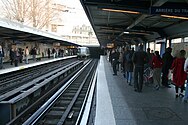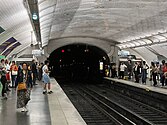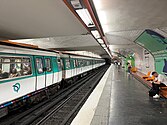Bastille station (Paris Métro)
Bastille | |||||||||||||||||||||
|---|---|---|---|---|---|---|---|---|---|---|---|---|---|---|---|---|---|---|---|---|---|
 Line 1 platforms. | |||||||||||||||||||||
| General information | |||||||||||||||||||||
| Location | Pl. de la Bastille (two) Boul. Bourdon × Boul. Henri IV 37, Boul. Bourdon 130, Rue de Lyon 140, Rue de Lyon 1, Rue de Charenton 1, Boul. Beaumarchais 2, Boul. Beaumarchais 4th, 11th and 12th arrondissement of Paris Île-de-France France | ||||||||||||||||||||
| Coordinates | 48°51′11″N 2°22′09″E / 48.853082°N 2.369077°E | ||||||||||||||||||||
| Owned by | RATP | ||||||||||||||||||||
| Operated by | RATP | ||||||||||||||||||||
| Line(s) | |||||||||||||||||||||
| Platforms | 6 | ||||||||||||||||||||
| Tracks | 6 | ||||||||||||||||||||
| Bus routes | |||||||||||||||||||||
| Bus operators | RATP, Noctilien | ||||||||||||||||||||
| Construction | |||||||||||||||||||||
| Structure type |
| ||||||||||||||||||||
| Accessible | No | ||||||||||||||||||||
| Other information | |||||||||||||||||||||
| Station code | 1212 | ||||||||||||||||||||
| Fare zone | 1 | ||||||||||||||||||||
| History | |||||||||||||||||||||
| Opened | |||||||||||||||||||||
| Services | |||||||||||||||||||||
| |||||||||||||||||||||
| Location | |||||||||||||||||||||
Bastille (French pronunciation: [bastij] ⓘ) is a station on Line 1, Line 5 and Line 8 of the Paris Métro. Located under the Place de la Bastille and near the former location of the Bastille, it is situated on the border of the 4th, 11th and 12th arrondissement.
Location
The station is located on Place de la Bastille, the platform being established:
- Line 1, south of the square, outside the Canal Saint-Martin (between Saint-Paul and Gare de Lyonstations);
- Line 5, west of the square between Quai de la Rapéestations, not including the Arsenal ghost station);
- Line 8, north of the square between Ledru-Rollinstations).
History
The Line 1 station opened as part of the first stage of the line between
It derives its name from the Place de la Bastille, symbolic place of the French Revolution, where the old fortress of the Bastille was destroyed between 14 July 1789 and 14 July 1790.
On 17 December 1906, the station of Line 5 was opened when the line was extended from
During the 1960s, the platform of Line 5 was renovated in the Mouton-Duvernet style with two-toned orange-tinted ceramic tiles, a white painted vault and characteristic lighting strips. Subsequently, they were equipped with seats Motte orange.
The platforms of Line 1 have been upgraded as part of its full automation. They are the last to be equipped with landing doors, in April 2011, because of the technical difficulty presented by the pronounced curve at their western end.
It saw 13,172,392 passengers enter in 2018, which places its attendance at the 10th position of all metro stations.[1]
Services for passengers
Access
The station has nine accesses from Place de la Bastille:
- Boulevard Henri-IV;
- Boulevard Bourdon;
- Rue de Lyon;
- Boulevard de la Bastille;
- Opera Bastille;
- Jardin du Port-de-l'Arsenal;
- Hospital Quinze-Vingts;
- Rue de la Roquette;
- Rue du Faubourg-Saint-Antoine.
The access leading to the Rue de Lyon was decorated with a Hector Guimard designed entrance registered as a historic monument on 29 May 1978. However, it was later moved to a metro station Boulevard Beaumarchais.
Station layout
| Line 1 platforms | Side platform with PSDs, doors will open on the right | |
| Westbound | ← Saint-Paul )
| |
| Dismantled Island Platform
| ||
| Eastbound | Château de Vincennes (Gare de Lyon ) →
| |
| Side platform with PSDs, doors will open on the right | ||
| 1F | Mezzanine for platform connection | |
| Street Level | Entrances/Exits | |
| B1 | Mezzanine for platform connection | |
| Line 5 platforms | Side platform, doors will open on the right | |
| Southbound | ← Quai de la Rapée )
| |
| Northbound | Bréguet – Sabin ) →
| |
| Side platform, doors will open on the right | ||
| Line 8 platforms | Side platform, doors will open on the right | |
| Westbound | ← Chemin Vert )
| |
| Eastbound | Ledru-Rollin ) →
| |
| Side platform, doors will open on the right | ||
Platforms
The stations of the lines meeting at Bastille all have side platforms.
The station belonging to Line 1 are very particular for several reasons; the station of this line is established on a very tight curve and counter curve, partly underground and part above ground. The western end of the line 1 platforms have the sharpest curve used by passenger trains on the Métro, with a radius of only 40 metres (131 ft).
The platforms of Line 5 are underground and have an elliptical vault. The decoration is the style used for the majority of metro stations. The lighting strips are white and rounded in the Gaudin style of l'Operation Espace Métro 2000, and the white ceramic tiles are covered the walls, the vault, the
The platforms of Line 8 are also underground under an elliptical vault. They are furnished in the Andreu-Motte style with two orange luminous ramps, benches and outlets in the corridors treated with flat brown tiles and Motte orange seats. These arrangements are married with the flat white ceramic tiles that cover the walls, vault and spandrels, making this station one of the few to have the Andreu-Motte preserved style. Advertising frames are metallic and the name of the station is Parisine typeface on enamelled plates. The station is distinguished however by the lower part of its walls which are vertical and not elliptical.
Bus connections
The station is served by lines 29, 69, 76, 86, 87 and 91 of the
Nearby
- Place de la Bastille, the location of the Bastille, stormed on 14 July 1789
- Opéra Bastille, opera house
- Gare de La Bastillerailway station.
- Bassin de l'Arsenal, boat basin
- July Column, a monument to the revolution of 1830
- Protestantchurch
Gallery
-
Line 1 platforms, with the dismantled island platform in the left (eastbound view)
-
Line 1 platforms(westbound view)
-
Two Sprague-Thomson trains negotiate the curve at the western end of the Line 1 platforms in 1908
-
An MP 89 train negotiating the same curve in 2007
-
Line 5 platforms
-
Line 8 platforms
Notes
- )
- ^ Hardy, B. Paris Metro Handbook, 3rd edition, Capital Transport Publishing, 1999.
References
- Roland, Gérard (2003). Stations de métro. D’Abbesses à Wagram. Éditions Bonneton.







